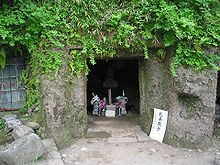Jufuku-ji
The Jufuku-ji ( Japanese 寿 福寺 ) is a Buddhist temple of the Kenchō-ji branch of the Rinzai-shū in the Ōgigayatsu ( 扇 ヶ 谷 ) district of the Japanese city of Kamakura ( Kanagawa Prefecture ) and belonged to the Gozan system in the Japanese Middle Ages .
history
The temple was originally built in 1200 to commemorate the first Kamakura shogun Minamoto no Yoritomo (1147–1199), who died the previous year, on the grounds of the residence of his father, Minamoto no Yoshitomo (1123–1160), by his widow Hōjō Masako ( 1156–1225) built. Eisai (1141-1215) was used as the first headmaster . Although Eisai was primarily a Zen master, in the first few years a mixture of esoteric Buddhism ( 密 教 , mikkyō ) and Zen was practiced at Jufuku-ji, which is why the Kenchō-ji, built in 1253, was the first pure Zen temple Kamakuras applies.
Eisai's successor at Jufuku-ji was Taikō Gyōyū ( 退耕 行 勇 ; 1163-1241), previously a priest at the Shintō shrine Tsurugaoka Hachiman-gū . Gyōyūs successor was Jyakuan Jōshō ( 寂 菴 上 昭 ; 1229-1316).
Other famous Zen masters who worked at Jufuku-ji include: a. Enni Ben'en (1202-1280), who was invited there by Hōjō Tokiyori in 1257 , and Lanxi Daolong (1213-1278).
Buildings
Special sights of the temple are the statues in the main hall ( 本 堂 , hondō ), which was last rebuilt between 1751 and 1763 , but which is not open to the public. Go- honzon is a 2.95-meter-high statue called Kago-Shaka ( 籠 釈 „;" basket Śākyamuni "because of a special manufacturing process), which is flanked by two (equally high) statues of the bodhisattvas Monju and Fugen . Other statues show u. a. an eleven-member Kan'non , Bodhidharma , Eisai and the Chinese Chan master Zhaozhou Congshen ( Chinese 趙州 從 諗 , Pinyin Zhàozhōu Cóngshěn , W.-G. Chao-chou Ts'ung-shen ; Japanese Jōshū Jūshin ; 778-897) .
The cemetery on the temple grounds is known for the burial sites of some famous people. There are u. a. the in the late Kamakura period and with five-story stupas ( 五 輪 塔 , gorintō ) equipped grotto tombs ( yagura ) for Hōjō Masako and her son, the third Kamakura-Shōgun, Minamoto no Sanetomo (1192-1219). However, these are only cenotaphs . The people actually buried in the cemetery include the haiku poet Takahama Kyoshi ( 高 浜 虚 子 ; 1874–1959), the writer Osaragi Jirō ( 大佛 次郎 ; 1897–1973) and the politician and diplomat Mutsu Munemitsu ( 陸 奥 宗 光 ; 1844–1897 ).
Web links
- Information on A Guide to Kamakura - English
- Information on Kamakura Citizens Net - English
- Photo gallery - Japanese
Coordinates: 35 ° 19 '27.34 " N , 139 ° 32' 56.48" O

